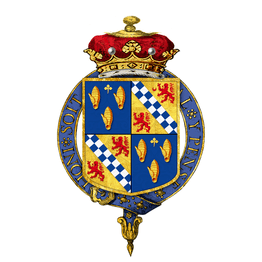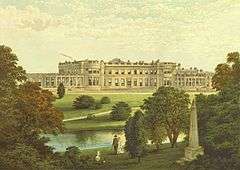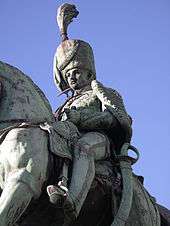Charles Vane, 3rd Marquess of Londonderry
| The Most Honourable The Marquess of Londonderry KG GCB GCH PC | |
|---|---|
Stewart%2C_Later_3rd_Marquess_of_Londonderry%2C_1812%2C_oil_on_canvas%2C_National_Portrait_Gallery%2C_London.jpg) | |
| Minister to Prussia | |
|
In office 1813–1814 | |
| Monarch | George III |
| Preceded by | No representation |
| Succeeded by | George Henry Rose |
| Ambassador to Austria | |
|
In office 1814–1823 | |
| Monarch |
George III George IV |
| Preceded by | The Earl of Aberdeen |
| Succeeded by | Hon. Sir Henry Wellesley |
| Personal details | |
| Born |
18 May 1778 Dublin, Ireland |
| Died |
6 March 1854 (aged 75) Londonderry House, Park Lane, London |
| Nationality | Irish |
| Spouse(s) |
Lady Catherine Bligh (d. 1812) Lady Frances Anne Vane-Tempest (d. 1865) |
| Children |
Frederick Stewart, 4th Marquess of Londonderry George Vane-Tempest, 5th Marquess of Londonderry Frances Anne Churchill, Duchess of Marlborough Alexandrina Dawson-Damer, Countess of Portarlington Lord Adolphus Vane-Tempest Lady Adelaide Emelina Caroline Vane Lord Ernest McDonnell Vane-Tempest |
| Parents |
Robert Stewart, 1st Marquess of Londonderry Lady Frances Pratt |
Charles William Vane, 3rd Marquess of Londonderry KG GCB GCH PC (1778 – 1854) was an Irish soldier in the British army, a politician, and a nobleman. As a soldier he fought in the French Revolutionary Wars, in the suppression of the Irish Rebellion of 1798, and in the Napoleonic wars. He excelled as a cavalry commander on the Iberic Peninsula under John Moore and Arthur Wellesley (Wellington).
After the war his half-brother Lord Castlereagh helped him to launch a diplomatic career. He was posted to Berlin in 1810, and then as Ambassador to Austria, where he attended the Congress of Vienna with his half-brother, the British plenipotentiary.
He was born Charles William Stewart and raised to the peerage as Baron Stewart in 1814. He married Lady Catherine Bligh in 1812 and then Lady Frances Anne Vane, a rich heiress, in 1819 changing his surname to hers. He succeeded his half-brother as 3rd Marquess of Londonderry in 1822. Queen Victoria made him a Knight of the Garter in 1853, and he died a year later in London.
Early life
Born in Dublin on 18 May 1778, Charles Stewart was the second son of Robert Stewart, an important landowner in Ireland but not yet a nobleman at the time. His father married twice. Charles's mother was his father's second wife, Frances, daughter of Charles Pratt, 1st Earl Camden and Chief Justice. His half-brother from his father's first marriage was Robert Stewart, Viscount Castlereagh, who made a brilliant diplomatic career. His half-brother's influence helped to ennoble his father and to advance Charles in his own diplomatic career.

.
'Fighting Charlie'
Charles Stewart was commissioned into the British Army at the age of 16, as a lieutenant. He saw service in 1794 in the Flanders Campaign of the French Revolutionary Wars. He was lieutenant colonel of the 5th Royal Irish Dragoons by the time he helped put down the Irish Rebellion of 1798. In 1803, Stewart was appointed aide-de-camp to King George III.
The remainder of his military career developed during the Napoleonic Wars, more exactly in the Peninsular War. The war started with the Corunna Campaign (1808–1809), in which the British troops were commanded by Sir John Moore. In this campaign Charles Stewart commanded a brigade of cavalry, and played, together with Lord Paget, a prominent role in the cavalry clash of Benavente.[1]
After the Corunna Campaign the British troops in the peninsula were commanded by Sir Arthur Wellesley (later the Duke of Wellington). Charles Stewart was appointed, in April 1809, Adjutant General to Wellesley. He distinguished himself, particularly at the battle of Talavera for which he received the thanks of the Parliament in February 1810. [2] He also excelled at Bussaco in September 1810 and at Fuentes d'Onoro. He resigned as Adjutant General in 1812[3] after some disagreement with Wellington, who appreciated him as a soldier but judged him a "sad brouillon and mischief-maker" [4] of whom he had to rid himself.
On 20 November 1813 he was made Colonel of the 25th Light Dragoons, becoming a Knight of the Bath that same year. He was also made Knight Grand Cross of the Guelphic Order (GCH) in 1816 and colonel of the 10th Hussars on 3 February 1820.
Political career
In 1796, he was elected to the Irish House of Commons as Tory representative for Thomastown, County Kilkenny, and after only two months exchanged this seat for that of Londonderry County. He sat for the latter constituency until the Act of Union in 1801, and then represented Londonderry in the British House of Commons until 1814. In 1807 he became Under-Secretary of State for War and the Colonies.
From 1813 until the end of the war he was Envoy Extraordinary and Minister Plenipotentiary to Berlin, and was also Military Commissioner with the allied armies, being wounded at the Battle of Kulm.
The recipient of numerous foreign honours, Stewart was also ennobled as Baron Stewart, of Stewart's Court and Ballylawn in County Donegal, in 1814.[5] In the same year he received honorary degrees from Oxford and Cambridge, was admitted to the Privy Council, and was appointed a Lord of the Bedchamber to the King.
He was also appointed Ambassador to Austria, a post he held for nine years (1814-1823), and was at the Congress of Vienna with his half-brother Lord Castlereagh as one of the British plenipotentiaries, where, according to the renowned historian Adam Zamoyski in his book Rites of Peace: The Fall of Napoleon and the Congress of Vienna, he made a spectacle of himself with his loutish behaviour, being apparently rather often inebriated, frequenting prostitutes quite openly, and once even starting a fist-fight in the middle of the street with a Viennese coach driver after he punched the coachman's horse. He quit the diplomatic service in 1823 after the death of his half-brother in 1822. Queen Victoria had a low esteem of the 3rd Marquess of Londonderry as a civil servant. She said that "Lord Londonderry should not be employed in any post of importance, as this would, in my opinion, be detrimental to the country".[6]
As Marquess
Back in England he befriended Louis-Napoléon Bonaparte (later Napoleon III) while the latter was exiled in London between 1836 and 1840. After Napoleon had been elected president of France in 1851, Charles asked him to free Abd-el-Kader.[7]
By the time of the Great Irish Famine in the 1840s, Londonderry was one of the ten richest men in the United Kingdom. While many landlords made efforts to mitigate the worst effects of the famine on their tenants, Londonderry was criticised for meanness: he and his wife gave £30 to the local relief committee but spent £150,000 renovating Mount Stewart, their Irish home.[8] Nevertheless Debbbie Orme maintains that "the Marquis was held in high regard in the land for his attempts to alleviate suffering during the potato famine".[9]
The entry for the Scrabo Tower in the Historical Building List states that "rather than the object of tenant affection, the 3rd marquis had alienated many of his tenantry through his unbending attitude during the tenant right campaign of the early 1850s".[10] He was in disagreement over this question with his son and heir Frederick, who was more liberally inclined.
Marriages and family

His first wife was Lady Catherine Bligh,[11] daughter of the 3rd Earl of Darnley. Charles married her in 1804 at the church of St George's, Hanover Square; she was three years older than he. She died during the night of 10–11 February 1812, of fever following a minor operation, while her husband was on his way home from Spain.[3]
Lord Stewart married his second wife, Lady Frances Anne Vane-Tempest, daughter and heiress of Sir Henry Vane-Tempest, on 3 April 1819 at her mother's house in Bruton Street, Mayfair and took her surname of Vane, by Royal licence, as had been stipulated in her father's will.[12] He was henceforth known as Charles William Vane, while his son out of his first marriage remained Frederick Stewart. He used his new bride's immense wealth to acquire the Seaham Hall estate in County Durham with a view to developing the coalfields there. He also built the harbour at Seaham, to rival nearby Sunderland.
He commissioned Benjamin Wyatt to build a mansion at Wynyard Park. It was completed by Philip Wyatt in 1841 and cost £130,000 (equivalent to £10,772,000 in 2016) to build and furnish. Unfortunately, just as the mansion was being completed, a fire broke out and gutted the house; it was later restored and remodelled by Ignatius Bonomi.
The family also used their newfound wealth to redecorate their country seat in Ireland, Mount Stewart, and bought Holdernesse House on London's Park Lane, which they renamed Londonderry House.
Lord Stewart succeeded his half-brother as 3rd Marquess of Londonderry in 1822. The following year he was created Earl Vane and Viscount Seaham, of Seaham in the County Palatine of Durham, with remainder to the heirs male of the body of his second wife.[13]

Governor of County Londonderry from 1823, Londonderry was appointed Lord Lieutenant of Durham in 1842 and the following year became Colonel of the 2nd Regiment of Life Guards. Queen Victoria finally made him a Knight of the Garter in 1853, and he died a year later at Londonderry House. Scrabo Tower was erected in his memory and his wife honoured by an equestrian statue in Durham.
He was succeeded as 4th Marquess of Londonderry by Frederick, the only child from his first marriage, and as 2nd Earl Vane by George, the eldest son from his second marriage.
He was styled The Honourable Charles Stewart from 1789 until 1813, The Honourable Sir Charles Stewart from 1813 to 1814, and finally The Lord Stewart from 1814 to 1822.
Issue
- Frederick William Robert Stewart, 4th Marquess of Londonderry (1805–1872)
- George Henry Robert Charles William Vane-Tempest, 5th Marquess of Londonderry (1821–1884)
- Lady Frances Anne Emily Vane (1822–1899); married John Spencer-Churchill, 7th Duke of Marlborough.
- Lady Alexandrina Octavia Maria Vane (1823–1874), godchild of Alexander I of Russia; married Henry Dawson-Damer, 3rd Earl of Portarlington.
- Lord Adolphus Frederick Charles William Vane-Tempest (1825–1864), politician; became insane, and had to be medically restrained.
- Lady Adelaide Emelina Caroline Vane (c.1830–1882); disgraced the family by eloping with her brother's tutor, Rev. Frederick Henry Law.
- Lord Ernest McDonnell Vane-Tempest (1836–1885), fell in with a press-gang and had to be bought a commission in the army, from which he was subsequently cashiered.
Through his daughter Lady Frances, Lord Londonderry was a great-grandfather of Winston Churchill.
Works
The 3rd Marquess has been a prolific writer and editor. He published books about his own military and diplomatic career and published many of his half-brother's papers. The following two books describe the Peninsular War as he saw it happen and the War of the Sixth Coalition, which forced Napoleon to abdicate:
- Vane, Charles William (1828). Narrative of the Peninsular War. London: Henry Colburn. Retrieved 16 July 2018. and
- Vane, Charles William (1830). Narrative of the War in Germany and France: In 1813 and 1814. London: Henry Colburn and Richard Bentley. Retrieved 26 July 2018.
The 3rd Marquess has also compiled, edited published many of the papers left by his half-brother and published them in the following twelve volumes:
- Vane, Charles William (1848). Memoirs and Correspondence of Viscount Castlereagh, Second Marquess of Londonderry - Vol. I - The Irish Rebellion. London: Henry Colburn. Retrieved 4 September 2018.
- Vane, Charles William (1848). Memoirs and Correspondence of Viscount Castlereagh, Second Marquess of Londonderry - Vol. II - Arrangements for a Union. London: Henry Colburn. Retrieved 4 September 2018.
- Vane, Charles William (1849). Memoirs and Correspondence of Viscount Castlereagh, Second Marquess of Londonderry - Vol. III - Completion of the Legislative Union. London: Henry Colburn. Retrieved 4 September 2018.
- Vane, Charles William (1849). Memoirs and Correspondence of Viscount Castlereagh, Second Marquess of Londonderry - Vol. IV - Concessions to Catholics and Dessenters: Emmett's Insurrection. London: Henry Colburn. Retrieved 4 September 2018.
- Vane, Charles William (1851). Correspondence Despatches and Other Papers of Viscount Castlereagh, Second Marquess of Londonderry - Vol. V - Military and Miscellaneous. London: William Shoberl. Retrieved 4 September 2018.
- Vane, Charles William (1851). Correspondence Despatches and Other Papers of Viscount Castlereagh, Second Marquess of Londonderry - Vol. VI - Military and Miscellaneous. London: William Shoberl. Retrieved 4 September 2018.
- Vane, Charles William (1851). Correspondence Despatches and Other Papers of Viscount Castlereagh, Second Marquess of Londonderry - Vol. VII - Military and Miscellaneous. London: William Shoberl. Retrieved 4 September 2018.
- Vane, Charles William (1851). Correspondence Despatches and Other Papers of Viscount Castlereagh, Second Marquess of Londonderry - Vol. VIII - Military and Miscellaneous. London: William Shoberl. Retrieved 4 September 2018.
- Vane, Charles William (1853). Correspondence Despatches and Other Papers of Viscount Castlereagh, Second Marquess of Londonderry - Vol. IX - Military and Diplomatic. London: John Murray. Retrieved 4 September 2018.
- Vane, Charles William (1853). Correspondence Despatches and Other Papers of Viscount Castlereagh, Second Marquess of Londonderry - Third Series Vol. II - Military and Diplomatic. London: John Murray. Retrieved 4 September 2018.
- Vane, Charles William (1853). Correspondence Despatches and Other Papers of Viscount Castlereagh, Second Marquess of Londonderry - Third Series Vol III. London: John Murray. Retrieved 4 September 2018.
- Vane, Charles William (1853). Correspondence Despatches and Other Papers of Viscount Castlereagh, Second Marquess of Londonderry - Vol. XII. London: John Murray. Retrieved 4 September 2018.
References
- ↑ Vane, Charles William (1828). Narrative of the Peninsular War. London: Henry Colburn. pp. 207–208. Retrieved 5 August 2018.
...Lord Paget and the writer of these pages arrived: when the former made haste to bring up the 10th hussars, whilst the latter put himself at the head of the detachments already in the field.
- ↑ https://api.parliament.uk/historic-hansard/commons/1810/feb/05/thanks-of-the-house-to-general-stewart
- 1 2 Dictionary of National Biography, Volume 54. London: Smith Elder & Co. 1898. pp. 278–281. Article on Charles William Stewart written by Ernest Marsh Lloyd.
- ↑ Jennings, Louis J. (1885). The Croker Papers. The correspondence and Diary f the Late Right Honourable John Wilson Croker LL.D.,FRS, Secretary to the Admiralty from 1809 to 1830. London: John Murray. p. 346.
Charles Stewart (third Marquis of Londonderry) was a sad brouillon and mischief-maker. I was obliged to get rid of him
- ↑ "No. 16909". The London Gazette. 18 June 1814. p. 1255.
- ↑ Urquhart, Diane (2007). The Ladies of Londonderry: Women and Political Patronage. London: I. B. Tauris. p. 65. ISBN 1-84511-410-8.
Queen Victoria's mandate 'that Lord Londonderry should not be employed in any post of importance, as this would, in her opinion, be detrimental to the country'
- ↑ "Miscellaneous". The Spectator. 12 April 1851. p. 8. Retrieved 19 July 2018.
Pardon me, my Prince, if I take the liberty to write to you ...
- ↑ http://www.historyireland.com/18th-19th-century-history/the-widows-mite-private-relief-during-the-great-famine/
- ↑ Orme, Debby. "The History of Scrabo Tower - Guardian of the North Down coast". Retrieved 7 April 2018.
- ↑ "Scrabo Tower - Historic Buildings Details". Department for Communities.
- ↑ "LADY CATHERINE BLIGH, LADY CHARLES STEWART". National Trust.
- ↑ https://www.thegazette.co.uk/London/issue/17480/page/906 ...may, in compliance with the provisions of the last will and testament of the said Sir Henry Vane, Bart. from henceforth continue to repectively use the surname of Vane only, ...
- ↑ "No. 17909". The London Gazette. 29 March 1823. p. 498.
External links
| Wikisource has the text of the 1885–1900 Dictionary of National Biography's article about Stewart, Charles William. |
- Hansard 1803–2005: contributions in Parliament by the Marquess of Londonderry